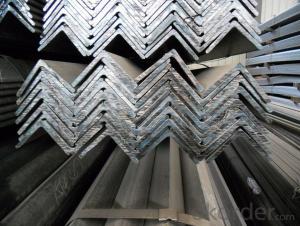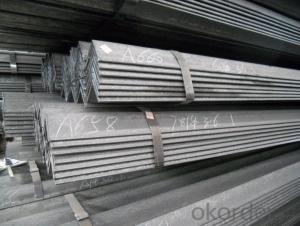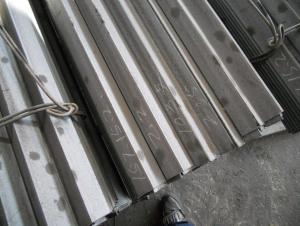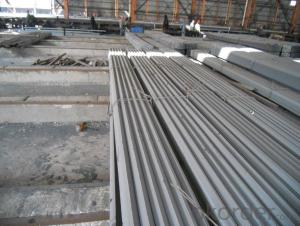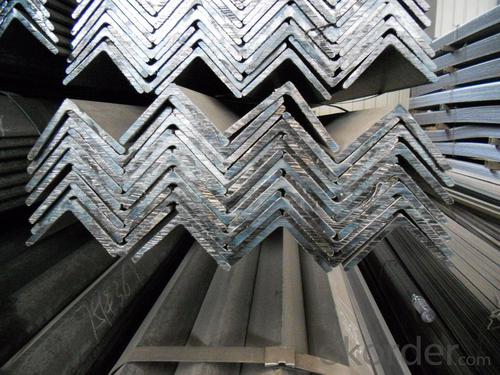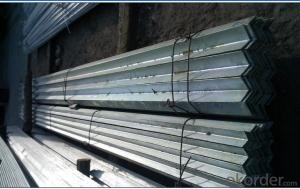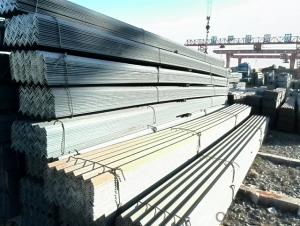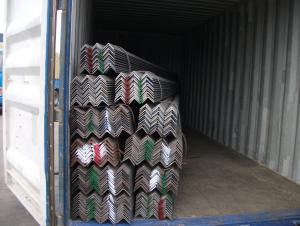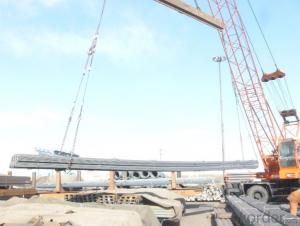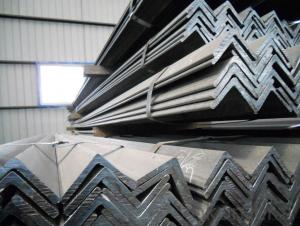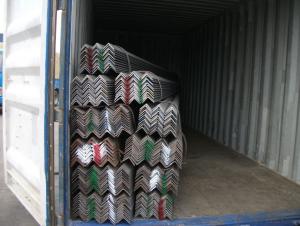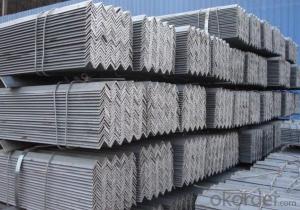Hot Rolled Equal Angle Steel with High Quality
- Loading Port:
- Tianjin
- Payment Terms:
- TT OR LC
- Min Order Qty:
- 20 m.t.
- Supply Capability:
- 1000 m.t./month
OKorder Service Pledge
OKorder Financial Service
You Might Also Like
Product Description:
OKorder is offering Hot Rolled Carbon Steel Equal Angle at great prices with worldwide shipping. Our supplier is a world-class manufacturer of steel, with our products utilized the world over. OKorder annually supplies products to European, North American and Asian markets. We provide quotations within 24 hours of receiving an inquiry and guarantee competitive prices.
Product Applications:
According to the needs of different structures, Angle can compose to different force support component, and also can be the connections between components. It is widely used in various building structures and engineering structures such as roof beams, bridges, transmission towers, hoisting machinery and transport machinery, ships, industrial furnaces, reaction tower, container frame and warehouse etc.
Product Advantages:
OKorder's Equal Angle are durable, strong, and resist corrosion.
Main Product Features:
· Premium quality
· Prompt delivery & seaworthy packing (30 days after receiving deposit)
· Corrosion resistance
· Can be recycled and reused
· Mill test certification
· Professional Service
· Competitive pricing
Product Specifications:
1. Invoicing on theoretical weight or actual weight as customer request
2. Length: 6m, 9m, 12m as following table
3. Sizes

Sizes: 25mm-250mm | ||
a*t | ||
25*2.5-4.0 | 70*6.0-9.0 | 130*9.0-15 |
30*2.5-6.6 | 75*6.0-9.0 | 140*10-14 |
36*3.0-5.0 | 80*5.0-10 | 150*10-20 |
38*2.3-6.0 | 90*7.0-10 | 160*10-16 |
40*3.0-5.0 | 100*6.0-12 | 175*12-15 |
45*4.0-6.0 | 110*8.0-10 | 180*12-18 |
50*4.0-6.0 | 120*6.0-15 | 200*14-25 |
60*4.0-8.0 | 125*8.0-14 | 250*25 |
Packaging & Delivery of Angle Steel
1. Packing: it is nude packed in bundles by steel wire rod
2. Bundle weight: not more than 3.5MT for bulk vessel; less than 3 MT for container load
3. Marks:
Color marking: There will be color marking on both end of the bundle for the cargo delivered by bulk vessel. That makes it easily to distinguish at the destination port.
Tag mark: there will be tag mark tied up on the bundles. The information usually including supplier logo and name, product name, made in China, shipping marks and other information request by the customer.
If loading by container the marking is not needed, but we will prepare it as customer request.
Production flow of Angle Steel
Material prepare (billet) —heat up—rough rolling—precision rolling—cooling—packing—storage and transportation
FAQ:
Q1: Why buy Materials & Equipment from OKorder.com?
A1: All products offered byOKorder.com are carefully selected from China's most reliable manufacturing enterprises. Through its ISO certifications, OKorder.com adheres to the highest standards and a commitment to supply chain safety and customer satisfaction.
Q2: How do we guarantee the quality of our products?
A2: We have established an advanced quality management system which conducts strict quality tests at every step, from raw materials to the final product. At the same time, we provide extensive follow-up service assurances as required.
Q3: How soon can we receive the product after purchase?
A3: Within three days of placing an order, we will begin production. The specific shipping date is dependent upon international and government factors, but is typically 7 to 10 workdays.

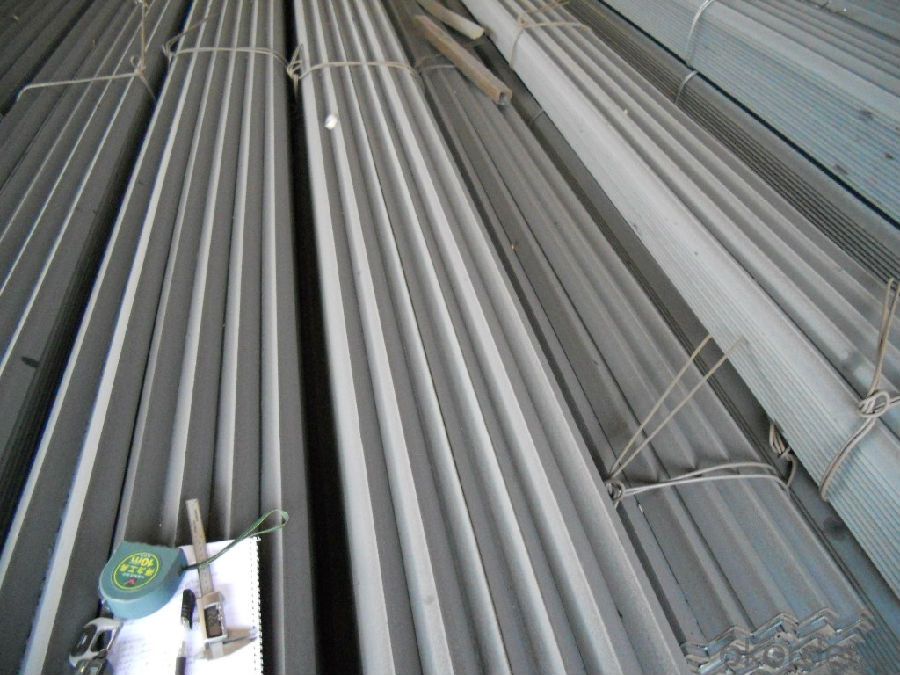
- Q: Can steel angles be used for sound barriers?
- Yes, steel angles can be used for sound barriers. Steel angles are commonly used in construction and can be suitable for sound barrier applications due to their durability, strength, and ability to absorb and block sound.
- Q: How do steel angles perform in terms of water resistance or waterproofing?
- Steel angles typically do not have inherent water resistance or waterproofing properties. Since steel is a metal, it is susceptible to corrosion and rust when exposed to water or moisture for extended periods of time. However, the water resistance or waterproofing of steel angles can be improved through various measures. One common method is to apply a protective coating, such as galvanizing or painting, to the steel angles. Galvanizing involves coating the steel with a layer of zinc, which acts as a barrier against water and prevents corrosion. Painting, on the other hand, creates a protective layer that helps to seal out moisture and prevent direct contact between the steel and water. Additionally, proper design and installation techniques can also enhance the water resistance of steel angles. For example, ensuring proper drainage and avoiding water accumulation on or around the steel angles can prevent long-term exposure to moisture, reducing the risk of corrosion. It is important to note that even with these measures, steel angles may still be susceptible to water damage if the protective coatings become compromised or if there is constant exposure to harsh environmental conditions. Regular inspection, maintenance, and prompt repair or recoating of the steel angles are essential to ensure long-lasting water resistance.
- Q: What are the different welding methods used for steel angles?
- Steel angles can be welded using various methods, depending on factors such as steel thickness, joint type, and desired outcome. Below are some commonly used welding methods for steel angles: 1. Stick welding, also known as Shielded Metal Arc Welding (SMAW), involves manually feeding a consumable electrode coated in flux into the joint. The flux creates a protective shield around the weld pool. SMAW is versatile and suitable for different joint configurations and thicknesses. 2. Gas Metal Arc Welding (GMAW), commonly referred to as MIG or MAG welding, uses a continuously fed wire electrode through a welding gun. The electrode melts and joins the steel angles together, while a shielding gas protects the weld pool. GMAW is fast and suitable for thin to medium thickness steel angles. 3. Flux-Cored Arc Welding (FCAW) is similar to GMAW, but the wire electrode is filled with flux, eliminating the need for external shielding gas. FCAW is versatile, easy to use, and can be used in various positions. It is commonly used for thicker steel angles and in outdoor applications where wind may affect gas shielding. 4. Gas Tungsten Arc Welding (GTAW), also known as TIG welding, uses a non-consumable tungsten electrode to create an arc. A separate filler metal is manually added to the joint, while a shielding gas protects the weld pool. GTAW produces high-quality, precise welds and is commonly used for thinner steel angles or when aesthetics are important. 5. Submerged Arc Welding (SAW) involves continuously feeding a wire electrode into the joint while covering the weld area with granular flux. The flux acts as a protective medium and prevents atmospheric contamination. SAW is commonly used for thicker steel angles and in applications where high deposition rates are required. These are just a few of the commonly used welding methods for steel angles. Each method has its advantages and limitations, and the choice should be based on project requirements. Consulting with a qualified welding professional is important to determine the most suitable method for a specific application.
- Q: What are the common design codes or standards for steel angles?
- Structural design of steel angles is governed by various design codes and standards, which guarantee their compliance with safety and performance criteria. The American Institute of Steel Construction (AISC) Manual of Steel Construction is widely recognized as a crucial design code for steel angles. This manual offers comprehensive guidelines and specifications for the design, fabrication, and erection of steel structures, encompassing angles as well. It provides intricate details regarding design strength, allowable stress levels, and geometric properties of angles. Besides the AISC Manual, other design codes and standards may also apply depending on the specific project and location. These include internationally recognized standards such as the Eurocode, British Standards (BS), and Australian Standards (AS). Each of these standards may have slight variations in their requirements for steel angle design and utilization. Therefore, referring to the relevant standard for a specific project is of utmost importance. Moreover, the American Society for Testing and Materials (ASTM) has established standards for the physical and mechanical properties of steel angles. These standards guarantee that the angles satisfy certain quality and performance requirements. Among the most commonly utilized ASTM standards for steel angles is ASTM A36, which outlines general requirements for carbon structural steel. To ensure structural integrity and reliability, common design codes and standards for steel angles provide guidance on crucial factors such as load capacity, strength, and safety considerations. By adhering to these codes and standards, steel angles are designed and employed in a manner that promotes their structural soundness and dependability.
- Q: Are steel angles suitable for load-bearing walls?
- Yes, steel angles are suitable for load-bearing walls. They are often used in construction as structural elements to provide support and stability. Steel angles have high strength and can effectively bear vertical loads, making them a reliable choice for load-bearing walls.
- Q: What are the different types of steel angles used in door and window frames?
- There are several types of steel angles commonly used in door and window frames, each offering unique benefits and applications. 1. L-shaped Angle: This is the most common type of steel angle used in door and window frames. It features a 90-degree angle and is typically used to provide structural support and reinforcement. L-shaped angles are versatile and can be easily welded or bolted into place, making them suitable for various frame designs. 2. T-shaped Angle: As the name suggests, T-shaped angles have a cross-section resembling the letter "T." They are often used to provide additional strength and stability to door and window frames. T-shaped angles are commonly used in heavy-duty applications where increased load-bearing capacity is required. 3. Equal Angle: Equal angles have two equal sides that form a 90-degree angle. They are commonly used in door and window frames that require equal support on both sides. These angles are suitable for applications where symmetry and balance are important, ensuring that the frame remains stable and level. 4. Unequal Angle: Unlike equal angles, unequal angles have two sides of different lengths. They are commonly used in door and window frames that require varying degrees of support on each side. Unequal angles are versatile and can be used to compensate for differences in wall thickness or other structural considerations. 5. Slotted Angle: Slotted angles are often used in door and window frames that require adjustable or modular designs. They feature a series of holes or slots along their length, allowing for easy attachment and customization. Slotted angles are commonly used in DIY projects or applications where flexibility and adjustability are desired. It is worth noting that the choice of steel angle for door and window frames depends on various factors such as the specific application, load-bearing requirements, and aesthetic considerations. Consulting with a structural engineer or a professional in the field can help determine the most suitable type of steel angle for a particular project.
- Q: Which is cheaper, angle iron or steel pipe?
- Steel pipe is not only used to transport fluid and powder solid, exchange heat energy, and manufacture mechanical parts and containers, but also is an economic steel. It can reduce weight and save 20 to 40% of metal by using steel pipe to make building structure, network frame, prop and mechanical support. Moreover, it can realize factory mechanization construction. Using steel pipe to manufacture road bridge can not only save steel, simplify construction, but also greatly reduce the area of coating protective layer, save investment and maintenance cost.
- Q: How do you prevent steel angles from twisting?
- To prevent steel angles from twisting, various methods can be utilized: 1. Accurate fabrication techniques: Ensuring precise and accurate fabrication of steel angles is crucial. This involves making straight and square cuts to maintain the angles' structural integrity and prevent twisting. 2. Implementation of bracing and supports: During installation, it is important to use suitable bracing and supports to provide stability. Temporary supports, diagonal bracing, or cross bracing can be employed, depending on the specific application. 3. Utilization of proper welding techniques: When joining steel angles, employing appropriate welding techniques helps minimize distortion and twisting. This includes selecting the correct welding process, controlling heat effectively, and using suitable fixturing to hold the angles in place during welding. 4. Adoption of anchoring methods: Depending on the application, anchoring methods such as bolting, screwing, or welding the steel angles to other structural elements can prevent twisting. These methods enhance stability and prevent rotation or twisting when subjected to external forces. 5. Regular inspections and maintenance: Conducting frequent inspections is important to identify any signs of twisting or distortion in steel angles. If any issues are detected, immediate corrective action should be taken to rectify the problem and prevent further twisting. By combining accurate fabrication, proper bracing and supports, suitable welding techniques, anchoring methods, and regular maintenance, steel angles can be effectively prevented from twisting, ensuring their structural stability in the long run.
- Q: What is the typical lead time for steel angle orders?
- The typical lead time for steel angle orders can vary depending on multiple factors such as the supplier, quantity, customization requirements, and current market conditions. However, in general, lead times for steel angle orders tend to range between 2 to 4 weeks. This allows for the processing of the order, manufacturing or sourcing the steel angles, and transportation to the desired location. It is important to note that lead times can be influenced by factors such as availability of raw materials, production capacity, and supplier's workload. Therefore, it is advisable to contact the specific supplier or manufacturer for accurate and up-to-date lead time information.
- Q: What are the different standards for steel angles?
- There are several different standards for steel angles, which are commonly used in construction and industrial applications. One of the most widely recognized standards is the American Society for Testing and Materials (ASTM) standard. ASTM A36 is a common grade for steel angles and specifies the chemical composition, mechanical properties, and tolerances for these structural shapes. It is commonly used for general structural purposes and is available in various sizes and lengths. Another prominent standard is the European standard, known as EN 10025. This standard includes several grades of steel angles, such as S235, S275, and S355, which correspond to different yield strengths. EN 10025 steel angles are widely used in construction, machinery, and engineering industries across Europe. In addition to these standards, there are also country-specific standards, such as the Japanese Industrial Standards (JIS) and the British Standards (BS). JIS G3101 is a well-known standard in Japan, which specifies the hot-rolled steel angles for general structures. BS EN 10056 is a British standard that provides specifications for steel angles used in construction. Furthermore, there are specialized standards for specific applications, such as marine-grade steel angles that are resistant to corrosion in saltwater environments. These standards, like ASTM A588, provide additional requirements for chemical composition and mechanical properties to ensure the steel angles' durability in harsh conditions. Overall, the different standards for steel angles ensure that these structural shapes meet specific requirements for strength, durability, and compatibility with various construction and industrial applications. It is crucial to refer to the appropriate standard when selecting steel angles to ensure they meet the necessary specifications for the intended use.
Send your message to us
Hot Rolled Equal Angle Steel with High Quality
- Loading Port:
- Tianjin
- Payment Terms:
- TT OR LC
- Min Order Qty:
- 20 m.t.
- Supply Capability:
- 1000 m.t./month
OKorder Service Pledge
OKorder Financial Service
Similar products
Hot products
Hot Searches
